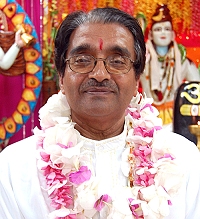From a satsang with Paramacharya of SWAHA, H. H. Pt. Hardeo Persad
Age after age, the Lord has manifested on earth to uphold righteousness (dharma) and shelter His devotees from evil forces. In the tradition of Sanaatan Dharma, creation unfolds through four distinct epochs, and in each, Gajaanand, the Ultimate Divinity, assumes a unique form, each rich with spiritual meaning.
In the primordial era of Satyug, Gajaanand appeared as Mohotkut Vinaayak, a majestic figure with ten arms, riding a lion. This radiant incarnation emerged to conquer the powerful demons Narantak and Devantak, restoring harmony to the universe.
During Treta Yug, the epoch of Shree Raam, the Divine took the form of Mayuresh, riding a peacock, with six arms. Mayuresh, a form given the peacock by Swami Kartikeya himself, appeared to destroy the demon Sindhu, once again affirming the triumph of dharma.
In the age of Dwapar Yug, during the time of Shree Krishna, He manifested as Gajaanan, a crimson-hued form with four arms, mounted on a mouse. His mission was to annihilate the demon Sindhur, thus continuing the eternal cycle of divine intervention.
In the present era of Kalyug, Gajaanan is foretold to incarnate as Dhumraketu, a smoke-coloured form with two arms, riding a horse. He will emerge to destroy the demons that plague this age, once more safeguarding the balance of creation.
The Katha of Mohotkut Vinaayak
In an ancient kingdom along the Ganga, Sage Rudraketu and his wife, Sharda longed for children. Through their devout sacrifices, they were blessed with two sons, Devantak and Narantak, whose names foretold their destiny as conquerors of gods and men.
Pleased with the sons’ devotion, Lord Shiva granted them a boon of invincibility, allowing them to conquer the three worlds—earth, heaven and the nether realms. However, as their power grew unchecked, the balance of dharma was threatened, leading to chaos and suffering.
During this tumultuous time, Sage Kashyap and his wife Aditi prayed and engaged in tapasya (austerities) that the Lord would incarnate as their child, expressing the pure love of a parent known as ‘Vatsalya Bhav’. The intense austerities pleased the Divine, and they were blessed with the birth of Mohotkut Vinaayak, a child of extraordinary strength and spiritual purpose.
Despite their formidable power, the demonic brothers, Devantak and Narantak, could not withstand the divine might of Mohotkut. Disguised as sages, they attempted to eliminate the child, but were instead vanquished by him, fulfilling their destiny at the hands of the Lord.
As Mohotkut grew, his fame spread across the land. One day, the king of Kaashi, seeking blessings for his son’s marriage, visited Sage Kashyap’s ashram. Engaged in lengthy spiritual practices, Kashyap sent Mohotkut in his place. Learning of this, Narantak plotted to attack Kaashi after the wedding. However, Mohotkut, embodying divine strength, defended the city and defeated Narantak and his army, restoring peace once more.
Enraged by his brother’s defeat, Devantak launched a new assault, creating eight powerful demons. In response, Mohotkut invoked eight divine Shaktis, or powers, which vanquished the demonic forces. During the final battle, Mohotkut transformed into the mighty Gajaanan, ultimately defeating Devantak and restoring balance to the cosmos.
With his mission complete, Gajaanan withdrew from the earthly plane, assuring his parents that he would remain present in astral form wherever Devi is worshipped, continuing to defend and guide all who seek righteousness.
The Inner Ages: Spiritual Growth in Our Daily Lives
The four ages of the world—Satyug, Treta Yug, Dwapar Yug and the present day Kalyug—are not only external epochs but also reflect the internal states of being. When our minds are clear and peaceful (sattvik prakriti), we experience the essence of Satyug. When we are active and passionate (rajas), tempered with wisdom (sattva), we experience the spirit of Treta Yug. Dwapar Yug reflects a mix of activity (rajas) and apathy (tamas), while Kalyug represents the tamasic mode of lethargy and confusion.
To progress spiritually, we must cultivate the qualities of sattva, or purity and light, within ourselves. Our thoughts, actions, and even the food we consume, influence our spiritual state. By nurturing sattva within, we can recreate the golden age of Satyug in our hearts, even amidst the challenges of Kalyug, defending ourselves from the negative influences in the world around us.



